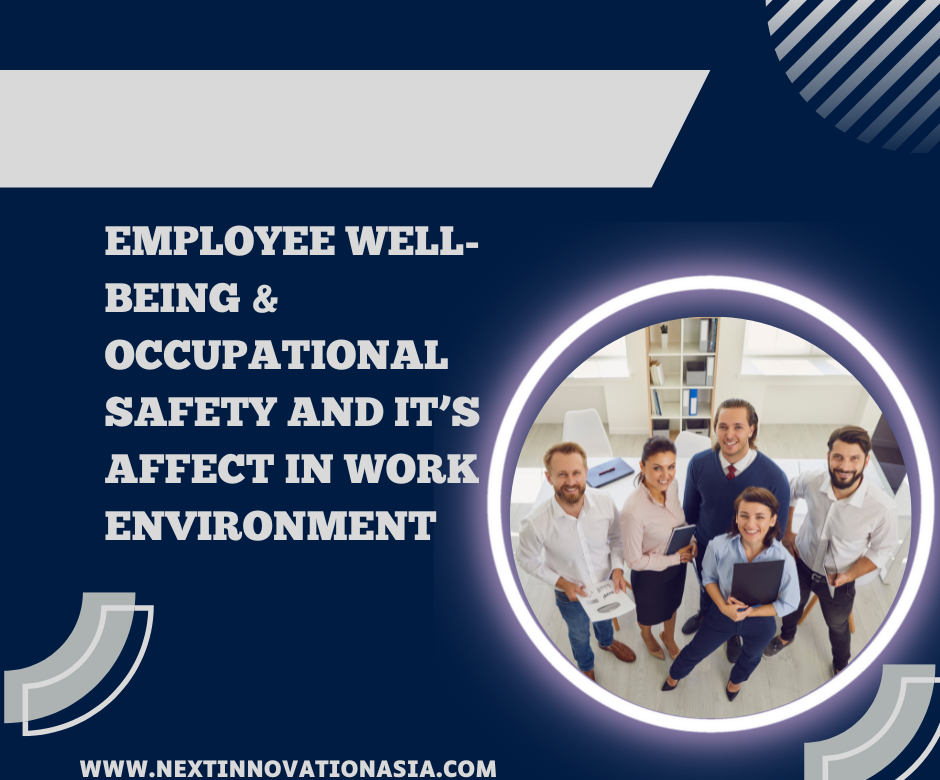What is employee well-being?
Employee well-being refers to the overall state of health, happiness, and satisfaction of individuals in the
workplace. It encompasses various aspects of an employee’s physical, mental, and emotional well-being.
Organizations that prioritize employee well-being recognize the importance of creating a positive work
environment that supports the holistic needs of their employees.
What is occupational safety?
Occupational safety refers to the practice of ensuring the physical, mental, and emotional well-being of
workers in the workplace. It involves identifying, assessing, and mitigating potential hazards, risks, and
dangers that could cause harm or injury to employees while they are performing their job duties.
Why does organizations need to focus on employee well being?
Employee well-being and occupational safety are crucial aspects of a healthy work environment.
Employers have a responsibility to ensure the physical, mental, and emotional well-being of their
employees while they are on the job. Here are some key points related to employee well-being and
occupational safety:
- Occupational Safety: Employers should prioritize the safety of their employees by implementing
measures to prevent accidents, injuries, and work-related illnesses. This includes maintaining a
safe and clean workplace, providing appropriate safety equipment and training, and conducting
regular risk assessments. - Work-Life Balance: Promoting work-life balance is essential for employee well-being. Employers
should encourage reasonable working hours, provide flexibility when possible, and promote
time off for rest and recreation. Encouraging breaks and discouraging excessive overtime can
help prevent burnout and improve overall well-being. - Physical Well-being: Employers should support employee physical well-being by providing a safe
and healthy work environment. This includes ergonomically designed workstations, proper
ventilation, access to clean drinking water, and facilities for personal hygiene. Encouraging
physical activity and promoting healthy habits can also contribute to employee well-being.
- Mental Health Support: Employers should recognize the importance of mental health and
provide support systems for their employees. This can involve offering employee assistance
programs (EAPs), organizing mental health awareness campaigns, providing access to counseling
services, and creating a supportive and inclusive work culture that reduces stigma around
mental health issues. - Training and Education: Employers should invest in training programs that educate employees
about occupational safety, hazard identification, and safe work practices. Providing ongoing
education and professional development opportunities can enhance employee skills and
confidence, leading to improved well-being and safety in the workplace. - Communication and Feedback: Open communication channels between employees and
management are crucial for addressing safety concerns and maintaining employee well-being.
Employers should establish channels for employees to report hazards, incidents, or health
issues, and ensure that feedback is acted upon promptly. Regular communication about safety
measures and initiatives can also promote a culture of transparency and trust. - Workplace Policies: Employers should have well-defined workplace policies that address issues
such as harassment, discrimination, and bullying. Creating a respectful and inclusive work
environment promotes employee well-being and fosters a sense of belongings.
Remember, these points serve as general guidelines, and specific regulations and requirements may
vary depending on the industry, location, and applicable laws. It’s important for employers to stay
informed about local regulations and consult relevant experts or authorities to ensure compliance with
safety and well-being standards.
What are the benefits of focusing on employee well being in an organization ?
some of the benefits are:
Improved employee performance: Employees who are healthy, happy, and engaged are more
productive and efficient at work. They also have higher levels of creativity, innovation, and problem-
solving skills.
Reduced employee turnover: Employees who feel valued, supported, and respected are more likely to
stay loyal to their employers. They also have lower levels of stress, burnout, and dissatisfaction that can
lead to quitting or absenteeism.
Enhanced employer reputation: Employers who invest in employee well-being can attract and retain top
talent, as well as improve their brand image and customer loyalty. They can also demonstrate their
social responsibility and commitment to sustainability.
Employee well-being is not just a nice-to-have, but a strategic imperative for any business that wants to
succeed in the long term.
Occupational safety measures organizations needs to take for employee well being:
Occupational safety measures are actions and policies that aim to protect the health and well-being of
workers in an organization. They can help prevent accidents, injuries, illnesses, and fatalities that may
occur due to work-related hazards and risks. Some of the occupational safety measures that an
organization can implement are12345:
Have accessible emergency exits: In case of an emergency, workers should be able to evacuate
the workplace quickly and safely. Emergency exits should be clearly marked, well-lit, and free of
obstructions.
Report unsafe conditions to management: Workers should be encouraged to report any hazards
or risks they encounter in their work environment, such as faulty equipment, spills, leaks, or
exposed wires. Management should take prompt action to correct the situation and prevent
harm.
Know the risks: Workers should be aware of the potential hazards and risks associated with their
tasks, as well as the preventive measures and protective equipment they need to use. They
should also receive adequate training and information on how to perform their work safely and
efficiently.
Be careful when lifting: Workers should follow proper lifting techniques and avoid lifting heavy
or awkward objects by themselves. They should also use mechanical aids, such as trolleys, carts,
or hoists, whenever possible to reduce the strain on their muscles and joints.
Use mechanical aids: Workers should use mechanical aids, such as trolleys, carts, or hoists,
whenever possible to reduce the strain on their muscles and joints.
Check out safety resources: Workers should have access to safety resources, such as manuals,
posters, videos, or online courses, that provide guidance and tips on how to prevent and deal
with occupational hazards and risks. They should also consult with occupational safety
professionals or experts if they have any questions or concerns.
Reduce stress in the workplace: Workers should try to manage their stress levels and cope with
work-related pressures in a healthy way. They should also seek support from their colleagues,
managers, or counselors if they feel overwhelmed or stressed out. Stress can affect workers’
mental and physical health, as well as their performance and productivity.
Know your surroundings: Workers should be familiar with their work environment and pay
attention to any changes or signs of danger. They should also keep their work area clean and
organized, and avoid distractions or interruptions that may affect their concentration or
judgment.
Occupational safety measures can benefit both workers and employers by creating a safer,
healthier, and more productive workplace.
Next Innovation Asia


